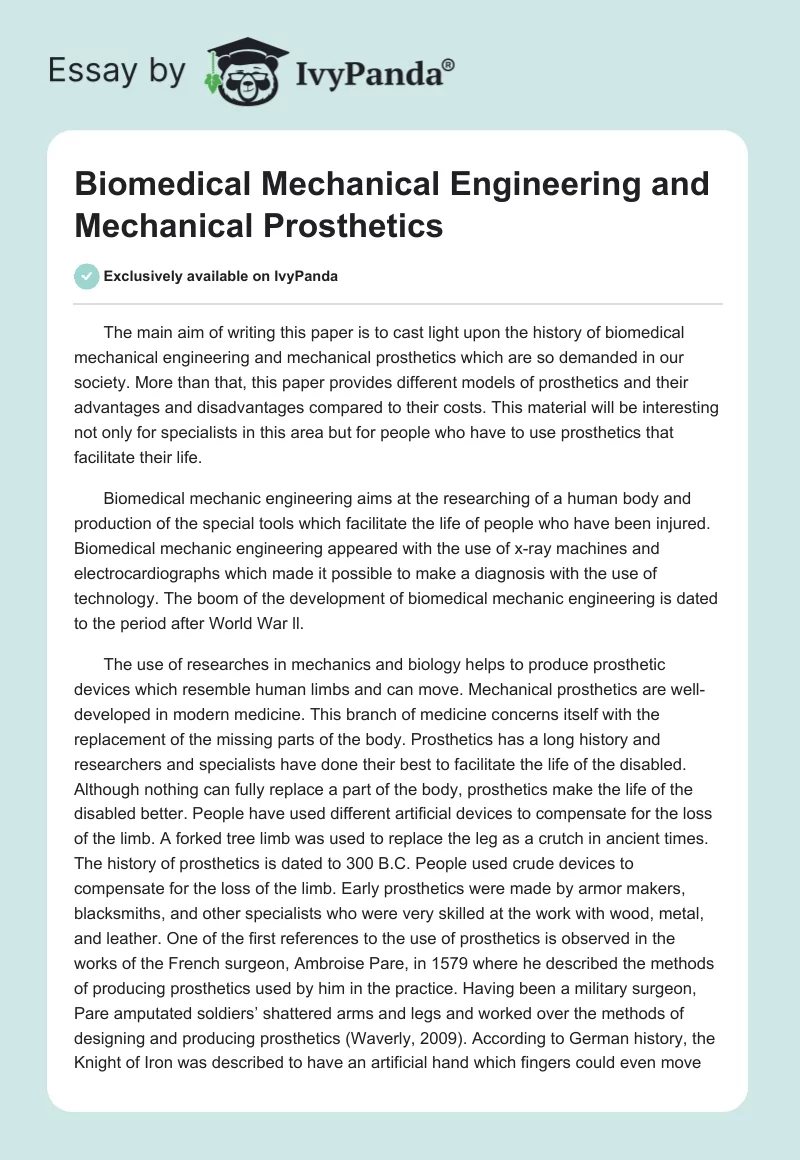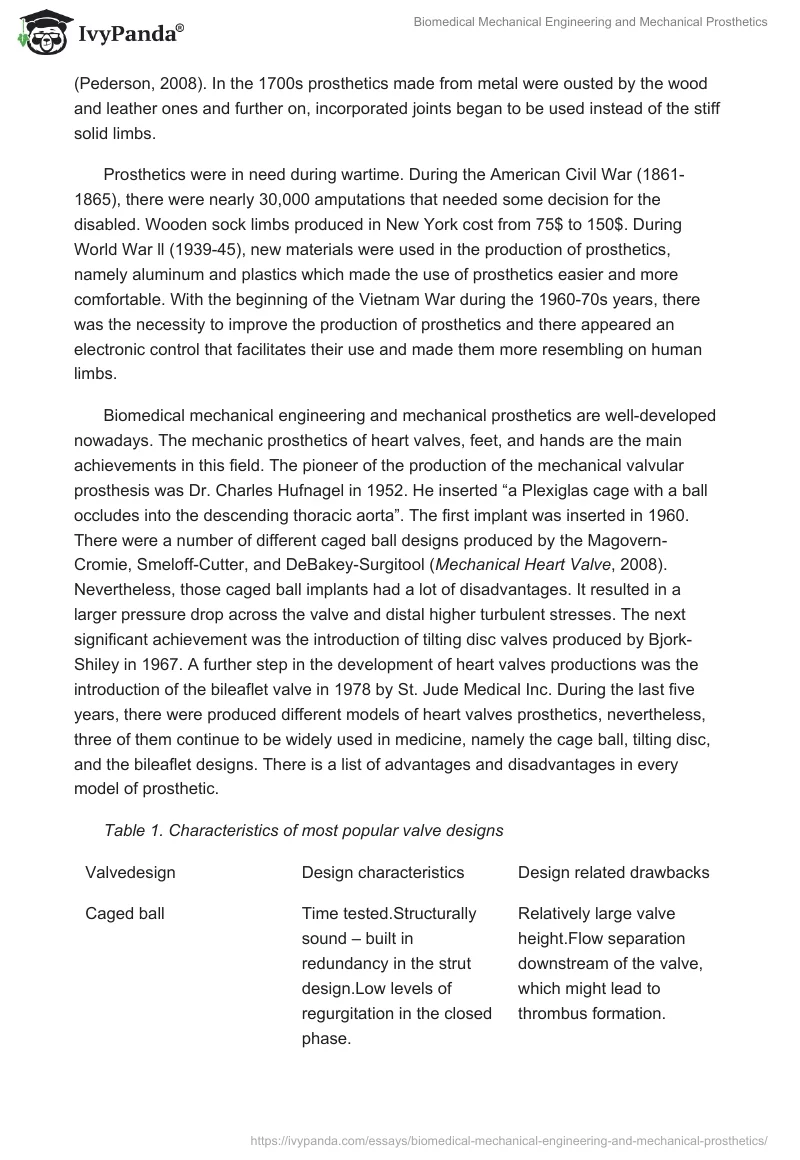The main aim of writing this paper is to cast light upon the history of biomedical mechanical engineering and mechanical prosthetics which are so demanded in our society. More than that, this paper provides different models of prosthetics and their advantages and disadvantages compared to their costs. This material will be interesting not only for specialists in this area but for people who have to use prosthetics that facilitate their life.
Biomedical mechanic engineering aims at the researching of a human body and production of the special tools which facilitate the life of people who have been injured. Biomedical mechanic engineering appeared with the use of x-ray machines and electrocardiographs which made it possible to make a diagnosis with the use of technology. The boom of the development of biomedical mechanic engineering is dated to the period after World War ll.
The use of researches in mechanics and biology helps to produce prosthetic devices which resemble human limbs and can move. Mechanical prosthetics are well-developed in modern medicine. This branch of medicine concerns itself with the replacement of the missing parts of the body. Prosthetics has a long history and researchers and specialists have done their best to facilitate the life of the disabled. Although nothing can fully replace a part of the body, prosthetics make the life of the disabled better. People have used different artificial devices to compensate for the loss of the limb. A forked tree limb was used to replace the leg as a crutch in ancient times. The history of prosthetics is dated to 300 B.C. People used crude devices to compensate for the loss of the limb. Early prosthetics were made by armor makers, blacksmiths, and other specialists who were very skilled at the work with wood, metal, and leather. One of the first references to the use of prosthetics is observed in the works of the French surgeon, Ambroise Pare, in 1579 where he described the methods of producing prosthetics used by him in the practice. Having been a military surgeon, Pare amputated soldiers’ shattered arms and legs and worked over the methods of designing and producing prosthetics (Waverly, 2009). According to German history, the Knight of Iron was described to have an artificial hand which fingers could even move (Pederson, 2008). In the 1700s prosthetics made from metal were ousted by the wood and leather ones and further on, incorporated joints began to be used instead of the stiff solid limbs.
Prosthetics were in need during wartime. During the American Civil War (1861-1865), there were nearly 30,000 amputations that needed some decision for the disabled. Wooden sock limbs produced in New York cost from 75$ to 150$. During World War ll (1939-45), new materials were used in the production of prosthetics, namely aluminum and plastics which made the use of prosthetics easier and more comfortable. With the beginning of the Vietnam War during the 1960-70s years, there was the necessity to improve the production of prosthetics and there appeared an electronic control that facilitates their use and made them more resembling on human limbs.
Biomedical mechanical engineering and mechanical prosthetics are well-developed nowadays. The mechanic prosthetics of heart valves, feet, and hands are the main achievements in this field. The pioneer of the production of the mechanical valvular prosthesis was Dr. Charles Hufnagel in 1952. He inserted “a Plexiglas cage with a ball occludes into the descending thoracic aorta”. The first implant was inserted in 1960. There were a number of different caged ball designs produced by the Magovern-Cromie, Smeloff-Cutter, and DeBakey-Surgitool (Mechanical Heart Valve, 2008). Nevertheless, those caged ball implants had a lot of disadvantages. It resulted in a larger pressure drop across the valve and distal higher turbulent stresses. The next significant achievement was the introduction of tilting disc valves produced by Bjork-Shiley in 1967. A further step in the development of heart valves productions was the introduction of the bileaflet valve in 1978 by St. Jude Medical Inc. During the last five years, there were produced different models of heart valves prosthetics, nevertheless, three of them continue to be widely used in medicine, namely the cage ball, tilting disc, and the bileaflet designs. There is a list of advantages and disadvantages in every model of prosthetic.
Table 1. Characteristics of most popular valve designs
As for the development of designing feet prosthetics, there are also a lot of models which are actively used in modern medicine. Nevertheless, it is impossible to produce flexible prosthetics which function in the same way as human feet. The design of prosthetics depends on the goals which must be achievedFirst of all, the foot prosthetic must be easy to carry and light in weight (Hansen, 2012). Cosmesis and volume are also very important goals. Modern feet prosthetics function as human parts of the body. Feet prosthetics allow standing, walking, and even running. The price of such models depends on the complexity of the design and its functions.
The prosthetics of hands are more complicated in their structure as far as all parts may be flexible and function as fingers. The hand is a very important part of our body which has a lot of functions necessary for our living. Early designs were quite bulky with electromechanical motors. New designs guarantee a 12 degree-of-freedom range of movement. They are more comfortable, more lightweight, and may be used both with the artificial or normal hand. The mechanical design consists of a combination of high-strength polymers such as PTFE and PEEK and low-density metals such as Titanium which make the prosthetics more flexible and resemble a human hand.
Prosthetics facilitate the life of disabled people. They do not want to be taken by other people like the disabled. They want to be equal to others and lead a life of full value. There are three main advantages of using prosthetics: energy, mobility, and psychological ones. People need less energy walking or doing something with the help of prosthetics compared to the use of crutches or other devices. If there is a choice between a wheelchair and the use of prosthetics, most people choose the last ones as far as prosthetics are more convenient and mobile. More than that, there are a lot of places which are not accessible by wheelchairs. According to Doug Hewitt, “Prosthetics provides a greater sense of independence” (2011). People using prosthetics have a more positive psychological outlook on the world than those who use crutches and wheelchairs. According to the Amputee Coalition of America, “amputees feel less discomfort with their conditions when wearing prosthetic legs because of the ability to blend in better with the crowd” (Hewitt, 2011).
Although there has been great success in the application of prosthetics, there are also complications that comprise primary valve failure, prosthetic valve thrombosis as well as mechanical hemolytic anemia (Johnson, 2010). Various complications come hand in hand with the applications of prosthetics. Some of these complications vary from severe to non-serious ones. There are a lot of cases of postoperative infections. For example, the prosthetics of the leg and hand may cause dermatitis in the place where the amputated limb is connected with the prosthetics. It may be the reason for ulcerations, infections, malignancies, and allergic contact dermatitis (ACD). More than that, prosthetics may be the cause of tissue proliferation at the amputation site which leads to the loss of feelings. Lumbar disfiguration may be caused by wearing the prosthetics for long period (Short-Term & Long-Term Effects of a Prosthetic Leg, n.d.). Another problem concerns with mechanic failure of prosthetics which causes a lot of non-serious and serious consequences. First of all, it may cause pain. That is why it is very important to follow all doctor’s instructions using prosthetics and to be examined regularly.
The cost of the prosthetics is another big challenge to the patients who lack some of the body parts as in acquiring them need one to be financially stable thus, excluding some from benefiting from them. The prosthetics also require frequent checkups to ensure that they give the required purpose to the patient. In some organs, it’s hard to mimic the natural organ and hence, some of the functions that can be performed by the normal hand or organ cannot be done by the mechanical prosthetic organ.
The cost of the prosthetics is in a position to go down with time as more biomedical engineers are coming up each day hence the prizes of the various prosthetics will go down as there will be competition from the different companies that will aim at marketing their products. A prosthesis leg may cost from $5.000 to $50.000 and the arm may have cost from $3.000 to 30.000$ (Turner, 2009). The costs of prosthetics depend on the material used in their production and the functions they have. Hand prosthetics are the most expensive and not everyone can afford to buy them. The muscle control over the arm is also in a position to increase as more flexible prosthetics are being formed that will help to control the muscle. This can be based on the comparison between the modern and the current kinds of prosthetics that are being manufactured (Turner, 2009).
The government recommends that the field of prosthetics as well as orthotics ought to be selected under the Act since the candidate group does not contain the required managerial resources as well as the monetary resources, to control the business by the act. The families recommend that the use of orthopedic brace be improved as this would help more people who suffer from these conditions. Also, the families recommend that the cost of the prosthetics be reduced as the high costs discriminate the poor from benefiting from the mechanical prosthetics that can only be acquired at high costs. More than that, there are doctors’ recommendations concerning the usage of prosthetics. There are a lot of consequences when the patients don’t follow the doctor’s instructions and use prosthetics in an inappropriate way. It should be noted that in every field the biomechanical engineering is necessary to improve. The government should support financially medical projects of improving prosthetics as far as the life of many people depends on them.
In conclusion, the various interventions on prosthetics ought to be emphasized as this has so far shown much help to the patients who lack the organs that can be replaced by artificial organs. Disabled people should be supplied with the necessary prosthetics despite their costs. The government should take care of these disabled people. In the same, the government should provide assistance to the engineers involved in making the prosthetics to ensure that they get the required resources needed.
References
Dasi, L., Simon, H., Sucosky, P. & Yoganathan, A. (2009). Fluid Mechanics of Artificial Heart Valves.
Hansen, A. (2012). Prosthetics: Foot and Ankle Prosthetics. International Encyclopedia of Rehabilitation. Web.
Hewitt, D. (2011). Advantages of Prosthetic Legs. Web.
Mechanical Heart Valve. (2008).
Pedersen, B. (2008). The History of Aesthetics of Prosthetics.
Short-Term and Long-Term Effects of a Prosthetic Leg. (n.d.). Web.
Turner, R. (2009). Prosthetic Costs. Disabled World towards tomorrow.
Waverly, J. (2009). The History of Prosthetics Legs. Web.


